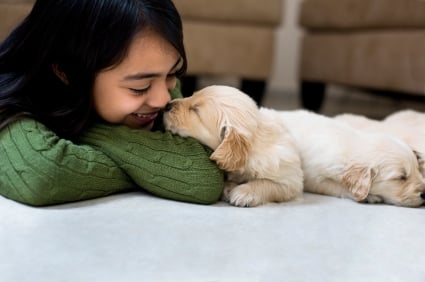Proper socialization: an essential part of quality dog training
The kind of dog obedience training for socialization that results in a happy, well-adjusted dog involves much more than merely exposing a puppy to people and environments. Frequently, we at Cleveland Dog Training Classes hear that owners, often those with shy puppies, mistakenly try to socialize their dogs by taking them to dog parks, shopping centers, little league games or group obedience classes for exposure to other people and dogs. But, in fact, strange people, cheering, jumping, barking and lunging dogs and maybe even with a tense owner, if not properly managed, can be overwhelming and negative.*

Proper socialization
To avoid overwhelming a dog, Cleveland Dog Training Classes guides you to learn a proper dog training socialization process that includes three elements:
- gradual progression
- positive exposure
- appropriate timing.
Gradual progression
When dog training to socialize a puppy, owners must introduce him to people and things in a way that won’t overwhelm him. Cleveland Dog Training Classes teaches you that, at first, sounds must be soft, motions slow and people and things, few and distant. In addition, we teach owners that they must be sensitive to their puppy’s feelings and behaviors to determine when it is time for louder, faster, closer and more. These factors and the amount of stimulation should be changed one at a time and increased gradually. And they should only be changed after their dogs are relaxed and have no stress reactions at the current level. For example, a vacuum cleaner involves at least three variables that affect a dog: the object, the noise, and the movement. Cleveland Dog Training Classes teaches you to
- introduce the puppy to the silent, still vacuum cleaner (object variable).
- turn on the vacuum but don’t move it (noise variable).
- move the vacuum without turning it on (movement variable).
When the puppy is at ease with each variable, combine them by turning on and moving the cleaner far from him. Remember to keep the movement slow and the puppy distant at first; then gradually increase the speed and/or decrease the distance.
Positive exposure
One way a puppy learns whether people and things are positive or negative is by “reading” facial expressions, body language, general demeanor, how big they are, do they stay still, and so on. Owners who want their puppy to approach new people and things with a positive attitude should also maintain a positive attitude . A puppy learns not only by direct experience but what goes on around him as well. So, people, like in the article,The Wellmeanings* must put Mr. Goodpuppy in situations where he can only succeed and receive praise. Owners must also protect their puppy from situations in which he’s most certain to get himself into trouble and experience negatives, directly and/or indirectly .
(You may enjoy reading about some unintentional mishaps in socialization such as those which occurred in the article, Mr. Goodpuppy’s Not So Silent Night and Mr Goodpuppy and the Well Meanings.)
Appropriate timing
In order to use gradual progression and positive exposure most effectively, it’s important to take first things first. This means that owners should first introduce Mr. Goodpuppy to people and environments in which the stimulation can be greatly controlled before exposing him to less predictable and possibly overwhelming situations.
For example, a puppy learns to trust people by first becoming comfortable with his primary family (the most controllable environment) and then being introduced to people who are willing and able to follow the proper socialization process (gradual progression and positive exposure). The same timing used with people should also be used for environments. First, owners should expose their puppies to the separate environments of their home (kitchen, family room, bedroom, etc.) and then other less-controlled but friendly environments (Grandma’s house, a dog-lover’s home, etc.). Eventually, the puppy is ready to go anywhere and everywhere with the expectation that all environments will be safe and friendly.
By experiencing this process for socialization, a puppy will come to expect all people and places to be positive. Should he then come across an occasional negative (chaotic kids, careless kicks, countless crashes, etc.), he is more likely to see these experiences as exceptions while still keeping his trusting and non-defensive disposition.
The happy ending
Owners can successfully socialize their puppy by following these Cleveland Dog Training Classes’ teaching methods that, gradually and positively and taking first things first, introduces your dog to the people and things of the “human world.” By doing this, “puppy parents” will be on the right track to shaping not only a well behaved dog, but also a well-adjusted one, the dog you’ll love to live with. And, both the puppy and his people can look forward to enjoying many peaceful times together.
*For fun articles dealing with improper socialization, see Mr. Goodpuppy’s Not So Silent Night and Mr. Goodpuppy and the Well Meanings
Karen’s knowledge, experience, use of her five-step model (See The Arnoff Model) and 30 years of client successes is why you’ll succeed with Cleveland Dog Training Classes (formerly the Dog-Owner Connection).

